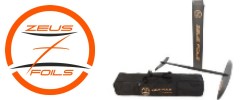How to use the Wind Window in kiteboarding
- Details
- WaterBoy
- Windsurfing

The wind window is the fundamental theory behind kiteboarding. Kites fly within the wind window, so you must learn how to manage the edge/neutral zone, the intermediate/soft zone, and the power zone.
What is the wind window? How do kiteboarders use the wind window to speed up and change directions? Understanding the concept of the wind window is critical if you want to progress in the sport of kiteboarding.
Basically, the wind window is the name given to the three-dimensional area downwind of the pilot that the kite can fly in. The length of the kite lines will determine the radius of that a particular wind window.
So, the longer the line, the larger the radius of the wind window. That is why kiteboarders use the clock - from 9 to 3 o'clock - to get the exact location of the kite above the water.
The three main zones of wind window will effectively impact the power of the kite. Mastering the intuitive technique of getting the kite where you want it to be will get you full control of the sport.
The three wind window zones are:
1. The Edge/Neutral Zone: in good winds, the kite can remain in stationary flight in this zone, producing little or no power.
2. The Intermediate/Soft Zone: the area downwind of the neutral zone, where the kite starts to move dynamically and produces power; the power generated within the intermediate zone is gradual, increasing the closer it is to the center point of the window or power zone.
3. The Power Zone: the most powerful area within the wind window and is used with sensible control; this zone is rarely needed except in light winds and when performing advanced tricks; the kite cannot be paused or stopped in this zone and will continue to fly towards the neutral zone.
If you're launching or landing a kite, you'll need to get it to the edge/neutral zone. A water start will require your kite to be in the power zone. You should not get your kite at 12 o'clock (Zenith) when at the beach.
If you're looking for maximum speed, send your kite into the power zone at between 9h30 and 10 o'clock. But remember, don't get overpowered in strong winds or violent wind gust conditions.
Never underestimate safety issues. Take a look at the Self Rescue and Pack Down kiteboarding guide, and learn the kite rules and safety sailing procedures.
Are into getting into kiteboarding? Get a trainer kite and read "ISAF Beginners Guide to Kiteboarding."








